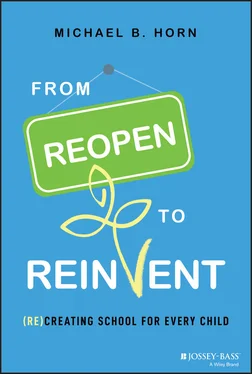Michael B. Horn - From Reopen to Reinvent
Здесь есть возможность читать онлайн «Michael B. Horn - From Reopen to Reinvent» — ознакомительный отрывок электронной книги совершенно бесплатно, а после прочтения отрывка купить полную версию. В некоторых случаях можно слушать аудио, скачать через торрент в формате fb2 и присутствует краткое содержание. Жанр: unrecognised, на английском языке. Описание произведения, (предисловие) а так же отзывы посетителей доступны на портале библиотеки ЛибКат.
- Название:From Reopen to Reinvent
- Автор:
- Жанр:
- Год:неизвестен
- ISBN:нет данных
- Рейтинг книги:4 / 5. Голосов: 1
-
Избранное:Добавить в избранное
- Отзывы:
-
Ваша оценка:
- 80
- 1
- 2
- 3
- 4
- 5
From Reopen to Reinvent: краткое содержание, описание и аннотация
Предлагаем к чтению аннотацию, описание, краткое содержание или предисловие (зависит от того, что написал сам автор книги «From Reopen to Reinvent»). Если вы не нашли необходимую информацию о книге — напишите в комментариях, мы постараемся отыскать её.
From Reopen to Reinvent,
From Reopen to Reinvent
From Reopen to Reinvent
From Reopen to Reinvent — читать онлайн ознакомительный отрывок
Ниже представлен текст книги, разбитый по страницам. Система сохранения места последней прочитанной страницы, позволяет с удобством читать онлайн бесплатно книгу «From Reopen to Reinvent», без необходимости каждый раз заново искать на чём Вы остановились. Поставьте закладку, и сможете в любой момент перейти на страницу, на которой закончили чтение.
Интервал:
Закладка:
This is because in today's system, time is held as a constant and each student's learning is variable.
Students move from concept to concept after spending a fixed number of days, weeks, or months on the subject. Educators teach, sometimes administer a test, and move students on to the next unit or body of material regardless of their results, effort, and understanding of the topic. Students typically receive feedback and results much later and only after they have progressed.
The system signals to students that it doesn't matter if you stick with something, because you'll move on either way. This approach undermines the value of perseverance and curiosity, as it does not reward students for spending more time on a topic. It also demotivates students, as many become bored when they don't have to work at topics that come easily to them or fall behind when they don't understand a building-block concept. Yet the class continues to progress, and students develop holes in their learning. This fixed-time, variable-learning system fails students.
Contrast this with a mastery-based—or competency-based 3 —learning model in which time becomes the variable and learning becomes guaranteed. Students only move fully from a concept once they demonstrate mastery of the knowledge and skills at hand. If they fail, that's fine. Failure is an integral part of the learning process. Students stay at a task, learn from the failures, and work until they demonstrate mastery. Success is guaranteed.
Mastery-based learning systematically embeds perseverance into its design. It showcases having a growth mindset, because students can improve their performance and master academic knowledge, skills, and habits of success.
Even if Jeremy's teachers talk about the importance of perseverance and growth mindset, today's system in which he's stuck doesn't reward it. It undermines it.
Similarly, by not providing timely feedback that is actionable, schools demotivate learners. Research shows that when a student receives feedback but cannot improve their performance with that feedback, it has a negative influence on student learning. Conversely, when the student can use the feedback, it positively impacts learning. 4 It also opens the door to more positive and personalized interactions with teachers to build trust.
Most schools also don't make a point of offering students access to new networks that help them discover new opportunities and endeavors beyond those of their immediate family and friends. Connecting students to new individuals can be life-altering. It brings students together with people who can open doors and allows them to build passions in areas about which they would never otherwise know. Introducing students to successful individuals, particularly those with whom they share commonalities, can inspire them. In life, success is often not about what you know, but who you know. There's a mountain of research to back that up.
But children like Jeremy struggle because they don't get these sorts of opportunities in school. And all too often they don't have the offerings in their own lives to compensate.
Sorting
As if this weren't bad enough, the current education system was built to rank and sort students out of the system at various intervals. It makes judgments about the capacity of students before they have had a fair chance to prove themselves.
The traditional grading system doesn't exist to convey what a student knows and can do. The grades are there to rank students—and sort them out of certain life paths. This didn't cripple an individual when the economy offered well-paying jobs for those who hadn't succeeded in school. But that no longer describes today's economy.
When Jeremy doesn't turn in his homework because he doesn't have a structure at home conducive to reminding him—and his school hasn't explicitly helped him develop his own self-direction and executive function skills—his grade is docked. And he can't change that because the grade is designed to label him so that schools know in which classes he should and shouldn't be enrolled.
Summative and standardized tests similarly aren't used to help students and teachers figure out how to make progress. They're used to help sort students into different pathways.
Tests aren't inherently bad. They are critical to learning. But when they are used as an autopsy on a student, as opposed to an actionable moment, they become counterproductive. If Jeremy developed a misconception in an earlier grade because he lacked the background knowledge to make sense of a concept that is critical to a new lesson he's tackling in the fifth grade, his lack of understanding will show up on a test. The implications will haunt him.
These structures of our schools are built from a historical legacy of sorting students into different careers, from factory-line workers to managers to leaders. They stem from a scarcity mentality—that there are only a few select opportunities such that we must select the few students who will benefit from them.
This zero-sum mindset—that for every winner there must be a loser—means that by age 18, before people have lived most of their lives, we have labeled the vast majority of students and signaled to many that they aren't good enough for certain pathways or that they are “below” others.
Although this might be easier administratively than the alternative, it is devastating. This overlooks talent that could be developed. And it ignores that so much of our society—like capitalism, when it works properly—is built on a positive-sum mindset. Schooling and its scarcity mindset are anomalies today.
As Todd Rose, author of The End of Average , told us on our Class Disrupted podcast, the opposite of a zero-sum game is a positive-sum one in which the pie grows larger as individuals achieve success. One of Adam Smith's central insights in the 1700s, Rose said, is that “the mercantilist idea of zero-sum economies was just fatally wrong” and that society should instead create the correct conditions in which self-interest could create positive-sum outcomes. A big benefit from moving to a positive-sum system is that instead of competing to be the best—as in a zero-sum game—you compete to be unique.
“The last thing you want to do is be competing with some other people on the exact same thing. It limits you. It limits your value,” Rose said. “[Our research shows that trying to be unique] translates into much higher life satisfaction.”
That's the opposite of those who compete to be their best, “in which even higher levels of achievement do not correlate with higher life satisfaction or happiness. So there's something about understanding how to compete, to be unique and achieving on that uniqueness. That matters both for personal fulfillment and the life I want to live, but also ultimately my greatest contribution to society.” 5
Competition can be good. Social comparisons can help an individual realize certain things are possible that they never otherwise would have imagined. But when we narrow the definition of life success and only rank and value people on a uniform and narrow dimension, competition is problematic. Competition is also a problem when we declare prematurely that the game is over.
That's because people don't learn in a linear way all on the same path and at the same pace. People develop at different rates. They have different strengths and weaknesses, which means they have what some call “jagged profiles.” That's because students have different working memory and cognitive capacities, background knowledge, social and emotional learning states, and contexts. 6 Customizing is critical to meet this reality and help every child fulfill their human potential. It's vital that we do not sort students out of a pathway too soon.
Читать дальшеИнтервал:
Закладка:
Похожие книги на «From Reopen to Reinvent»
Представляем Вашему вниманию похожие книги на «From Reopen to Reinvent» списком для выбора. Мы отобрали схожую по названию и смыслу литературу в надежде предоставить читателям больше вариантов отыскать новые, интересные, ещё непрочитанные произведения.
Обсуждение, отзывы о книге «From Reopen to Reinvent» и просто собственные мнения читателей. Оставьте ваши комментарии, напишите, что Вы думаете о произведении, его смысле или главных героях. Укажите что конкретно понравилось, а что нет, и почему Вы так считаете.












